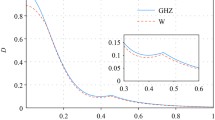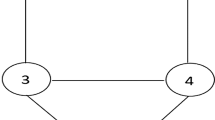Abstract
If a pure state of a qubit pair is developed over the four basis states, an equality between the four coefficients of that development, verified if and only if that state is unentangled, is already known. This paper considers an arbitrary pure state of an N-qubit system, developed over the \(2^{N}\) basis states. It is shown that the state is unentangled if and only if a well-chosen collection of \([2^{N}-(N+1)]\) equalities between the \(2^{N}\) coefficients of that development is verified. The number of these equalities is large a soon as \( N\gtrsim 10\), but it is shown that this set of equalities may be classified into \((N-1)\) subsets, which should facilitate their manipulation. This result should be useful e.g. in the contexts of blind quantum source separation and blind quantum process tomography, with an aim which should not be confused with that found when using the concept of equivalence of pure states through local unitary transformations.
Similar content being viewed by others
Notes
Other approaches perform BQSS directly, i.e. without first resorting to BQPT.
References
Bell, J.S.: Speakable and Unspeakable in Quantum Mechanics, 2nd edn. Cambridge University Press, Cambridge (2004)
Branderhorst, M.P.A., Nunn, J., Walmsley, I.A., Kosut, R.L.: Simplified Quantum Process Tomography. (2009) arXiv:0910.4609 version 2
Buchleitner, A., Viviescas, C., Tiersch, M.: Entanglement and Decoherence. Springer, Basel (2009)
Comon, P., Jutten, C. (eds.): Handbook of Blind Source Separation. Independent Component Analysis and Applications. Academic Press, Oxford (2010)
Deutsch, D.: Quantum theory, the Church–Turing principle and the universal quantum computer. Proc. R. Soc. Lond. A 400, 97–117 (1985)
Deville, Y., Deville, A.: Classical-processing and quantum-processing signal separation methods for qubit uncoupling. Quantum Inf. Process. 11, 1311–1347 (2012)
Deville, Y., Deville, A.: From blind quantum source separation to blind quantum process tomography. In: Proceedings of the 12th International Conference on Latent Variable Analysis and Signal Separation (LVA/ICA 2015), pp. 184–192. Springer, Basel (2015)
Deville, Y.: Blind source separation and blind mixture identification methods. In: Webster, J. (ed.) Wiley Encyclopedia of Electrical and Electronics Engineering, pp. 1–33. Wiley, New York (2016)
Deville, A., Deville, Y.: Concepts and criteria for blind quantum source separation and blind quantum process tomography. Entropy 19, 311–329 (2017)
Deville, Y., Deville, A.: Blind quantum source separation: quantum-processing qubit uncoupling systems based on disentanglement. Digit. Signal Process. 67, 30–51 (2017)
Deville, Y., Deville, A.: The blind version of quantum process tomography: operating with unknown input values. In: Proceedings of World Congress IFAC 2017, pp. 12228–12234 (2017)
Electrons et photons: Rapports et discussions du cinquième Conseil de physique (Bruxelles, 24–29 octobre 1927, Institut international de physique Solvay), Paris, Gauthier-Villars (1928)
Feynman, R.: Quantum mechanical computers. Opt. News 11(2), 11–20 (1985)
Horodecki, R., Horodecki, P., Horodecki, M., Horodecki, K.: Quantum entanglement. Rev. Mod. Phys. 81, 865–942 (2009)
Laloë, F.: Comprenons-nous vraiment la mécanique quantique? EDP Sciences, Les Ulis, France, 2011; English Version: Do We Really Understand Quantum Mechanics?. Cambridge University Press, Cambridge (2012)
Matsuura, A., Johri, S., Hogaboam, J.: A system perspective of quantum computing. Phys. Today 41(3), 40–46 (2019)
Merkel, S.T., Gambetta, J.M., Smolin, J.A., Poletto, S., Córcoles, A.D., Johnson, B.R., Ryan, C.A., Steffen, M.: Self-consistent quantum process tomography. Phys. Rev. A 87, 062119-1–062119-9 (2013)
Nielsen, M.A., Chuang, I.L.: Quantum Computation and Quantum Information. Cambridge University Press, Cambridge (2000)
Paty, M.: The nature of Einstein’s objections to the Copenhagen interpretation of quantum mechanics. Found. Phys. 25, 183–204 (1995)
Peres, A.: Quantum Theory: Concepts and Methods. Kluwer Academic Publishers, Dordrecht (1995)
Schrödinger, E.: Discussion of probability relations between separated systems. Math. Proc. Camb. Philos. Soc. 31(4), 555–563 (1935)
Schumacher, B.: Quantum coding. Phys. Rev. A 51(4), 2738–2747 (1995)
Shukla, A., Mahesh, T.S.: Single-scan quantum process tomography. Phys. Rev. A 90, 052301-1–052301-6 (2014)
Takahashi, M., Bartlett, S.D., Doherty, A.C.: Tomography of a spin qubit in a double quantum dot. Phys. Rev. A 88(2), 022120-1–022120-9 (2013)
Hooft, G.: The Cellular Automaton Interpretation of Quantum Mechanics. Fundamental Theories of Physics, vol. 185. Springer, New York (2016)
Walter, M., Gross, D., Eisertz, J.: Multi-partite Entanglement (2017) arXiv:1612.02437v2 [quant-ph]
White, A.G., Gilchrist, A.: Measuring two-qubit gates. J. Opt. Soc. Am. B 24, 172–183 (2007)
Author information
Authors and Affiliations
Corresponding author
Additional information
Publisher's Note
Springer Nature remains neutral with regard to jurisdictional claims in published maps and institutional affiliations.
A The von Neumann entropy and the establishment of the iff condition
A The von Neumann entropy and the establishment of the iff condition
The entropy concept, which did not appear in this paper yet, is briefly considered here. The von Neumann entropy of a quantum system in a pure or mixed state described by a density operator \(\rho \) is the trace \(S=-Tr(\rho Ln\rho )\). This concept cannot directly be used in an attempt to find an iff condition for the unentanglement of a pure state \(\left| \varPsi \right\rangle \) of an N-qubit system, since its von Neumann entropy is zero for both unentangled and entangled pure states. But this N-qubit system can be viewed as a bipartite system \(\varSigma \), composed of parts \(\varSigma _{A}\) and \( \varSigma _{B}\), and if \(\varSigma \) is described by \(\rho \), one may first introduce reduced density operators \(\rho _{A}=Tr_{B}\rho \) and \(\rho _{B}=Tr_{A}\rho \) (see e.g. [20]). From now on, we focus on the situation when \(\rho =| \varPsi \rangle \langle \varPsi | \). Both \(\varSigma _{A}\) and \( \varSigma _{B}\) possess orthonormal basis states \(\left| \varphi _{i}^{A}\right\rangle \) and \( \left| \chi _{i}^{B}\right\rangle \) allowing to write any pure state \(\left| \varPsi \right\rangle \) of \( \varSigma \) as \(\left| \varPsi \right\rangle =\sum _{i}\lambda _{i}\left| \varphi _{i}^{A}\right\rangle \otimes \left| \chi _{i}^{B}\right\rangle \) (Schmidt decomposition), where the sum of the squares of the real non-negative so-called Schmidt coefficients \(\lambda _{i}\) is equal to 1 (see e.g. [18]). Moreover, \(\rho _{A}\) and \(\rho _{B}\) have the same eigenvalues, equal to \(\lambda _{i}^{2}\) [18]. One introduces the entropies for \(\varSigma _{A}\) and \(\varSigma _{B}\), respectively, \(S_{A}=-Tr_{A}(\rho _{A}Ln\rho _{A})\) and \(S_{B}=-Tr_{B}(\rho _{B}Ln\rho _{B})\), and, as a result of both the Schmidt decomposition and the just mentioned property of the eigenvalues of \(\rho _{A}\) and \(\rho _{B}\), \(S_{A}=S_{B}=-\sum _{i}\lambda _{i}^{2}Ln\lambda _{i}^{2}\). Then \(S=0\), while \(S_{A}=S_{B}\ge 0\), and \( \left| \varPsi \right\rangle \) is unentangled if and only if \(S_{A} = S_{B}\) is equal to zero. A means of establishing an iff condition through the reduced entropy concept therefore does in principle exist. But the fact that the reduced entropy of a bipartite system is related to the Schmidt decomposition immediately suggests that, if this concept is used as a tool for establishing an iff condition for the \(c_{i}\) introduced in this paper, the difficulty will be at least as great as the one found with the Schmidt criterion, already discussed in Sect. 2.
Let us first examine the two-qubit case: A is qubit 1 and B qubit 2. Then, keeping our previous notations, \(\left| \varPsi \right\rangle =\sum _{i=1}^{4}\,c_{i}\left| i\right\rangle \), one has first to express the condition \(S_{A}=0\) as a function of the \(c_{i}\) coefficients, but this means: (1) calculating the expression of \(\rho _{A}\), (2) calculating its eigenvalues, (3) calculating \(S_{A}\) and solving the equation \(S_{A}=0\). The reader may verify that a tedious calculation leads to our well-known result:
The next simplest situation is \(N=3\), and one may first introduce \(\rho _{3}\), the reduced entropy for qubit no. 3, and focus on the corresponding reduced entropy \(S_{3}= -Tr_{3}(\rho _{3}Ln\rho _{3})\), which is zero iff \(\left| \varPsi \right\rangle \) is unentangled. This necessitates first to calculate all the elements of the reduced density matrix \(\rho _{3}\), each one a complicated sum involving our \(c_{i}\) coefficients, and secondly to find an analytical expression for the eigenvalues of \(\rho _{3}\). But, once this is done, one knows that if and only if one and only one eigenvalue is nonzero, and therefore equal to one, then the state is unentangled. Considering the reduced entropy \(S_{3}\), i.e. manipulating sums of quantities involving logarithms, is therefore unnecessary.
Rights and permissions
About this article
Cite this article
Deville, A., Deville, Y. N-qubit system in a pure state: a necessary and sufficient condition for unentanglement. Quantum Inf Process 18, 320 (2019). https://doi.org/10.1007/s11128-019-2433-0
Received:
Accepted:
Published:
DOI: https://doi.org/10.1007/s11128-019-2433-0




